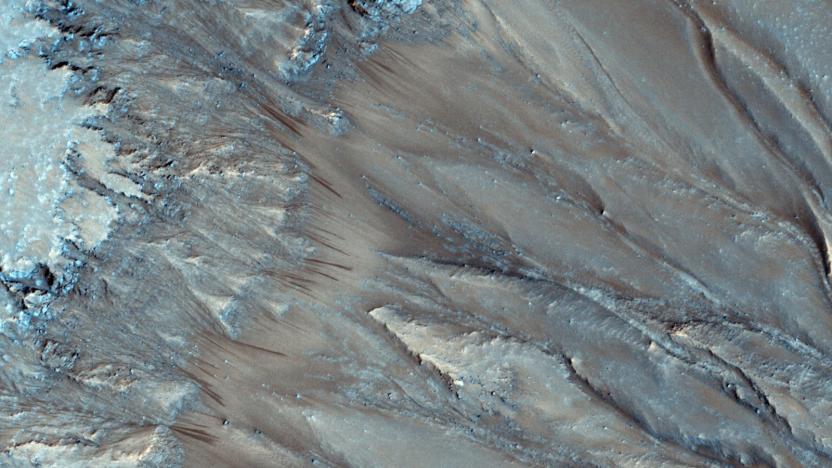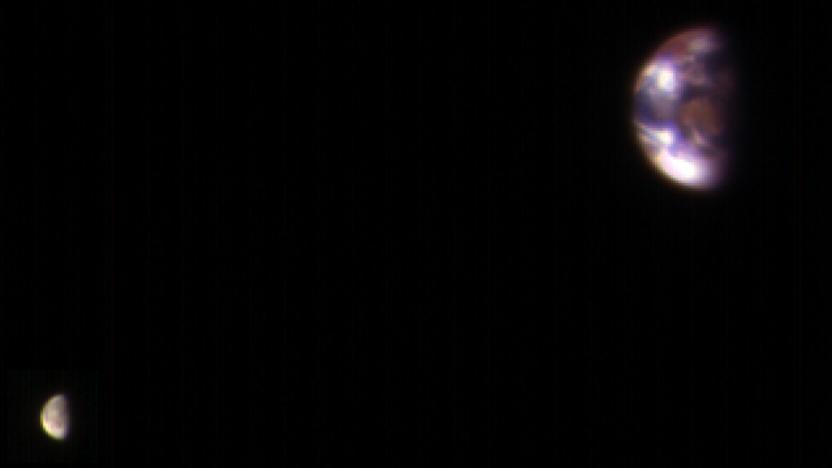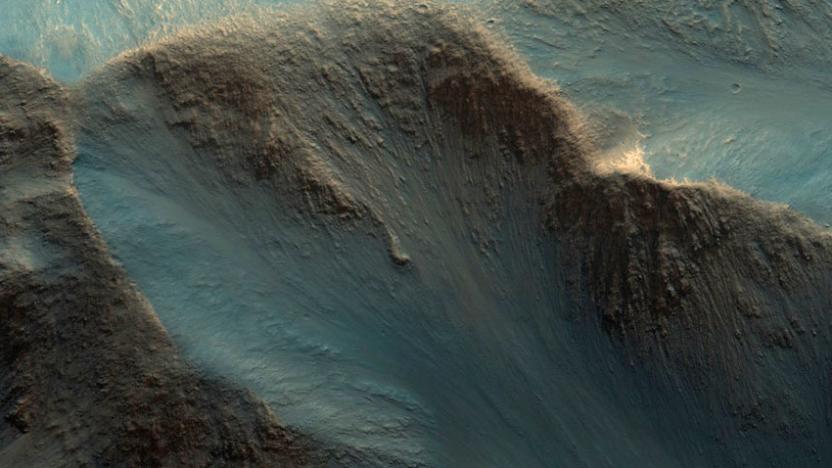MarsReconnaissanceOrbiter
Latest

Dust storms may have stolen all of Mars' water
In May 2018, Opportunity had been doing science on Mars since 2004, and there was no reason to think that the plucky rover wouldn't carry on. Then, a dust storm hit that completely obscured the planet from view. After fine dust coated Opportunity's solar panels, the rover apparently lost power and was declared dead by NASA in February 2019. Now, scientists think similar storms may have also delivered a coup de grace to water on Mars, stripping it from its surface for good.

Orbiter flaw may have ruled out some signs of water on Mars
You might not want to get too excited about the prospects of finding water on Mars. A recently published study has determined that the Mars Reconnaissance Orbiter's approach to handling water data is flawed, potentially invalidating some earlier discoveries of salty water flows. The machine's Compact Reconnaissance Imaging Spectrometer for Mars (CRISM) can be confused by some high-contrast areas, and the software used to correct that data can inadvertently produce false signs of perchlorates that hint at salt water flows. There appeared to be an abundance of perchlorates in the corrected results, but there doesn't appear to have been any in the raw data.

NASA images show Martian dust storms engulfing the entire planet
Martian dust storms can make nasty sand devils look cute, and every six to eight years, they can grow large enough to engulf the whole planet. Global-scale storms happen when several smaller ones kick up enough dust to envelope the planet's surface. But since they only occur every once in a while, scientists still don't know much about them, including why they form and how exactly they evolve. They'll soon have a treasure trove of data to work with, though, now that NASA'S Martian probes have trained their eyes on a massive storm that's currently covering the planet with cloud and haze.

NASA finds easy-to-access water all over Mars
NASA and private companies like SpaceX are busy planning Mars missions, but only have a vague idea of how they're going to find critical water supplies. Now, using the Mars Reconnaissance Orbiter (MRO), researchers have discovered abundant, easy-to-access H20. A survey found no less than eight sites where cliff erosion has exposed thick deposits of nearly pure ice that lie just three to six feet below rock and dust. The findings mean that future missions, both manned and robotic, may have an easier time than expected digging up water for drinking and making rocket fuel.

Dark streaks on Mars may not be caused by flowing water
In 2015, scientists analyzing mysterious dark streaks on the surface of Mars found evidence that they were formed by liquid water -- an exciting discovery that meant microbial life might be supported on the planet. But new findings published this week in Nature Geoscience suggest it might not be liquid water after all.

Swiftly-falling snowstorms may fall at night on Mars
Certain areas of Mars develop clouds at night that drop icy rain rather quickly -- and in some areas, perhaps snow. While neither have been strictly observed, researchers have developed new computer models that forecast frozen precipitation on the red planet, which might lead to snowy drifts. And while science had previously theorized that Martian precipitation in these storms took hours to descend one mile, the new predictions shave that down to minutes under certain conditions.

See how NASA envisions a 'Mars 2030' landing in VR
Just because you can't go with the astronauts NASA chooses for the first manned mission to Mars doesn't mean you can't experience the Red Planet for yourself. A NASA-approved virtual experience called Mars 2030 has just landed on the HTC Vive, the Oculus Rift and the PC through Steam. It puts you in the space shoes of an astronaut exploring 15 miles of Martian landscape, which was modeled after the planet's real surface as captured by Mars Reconnaissance Orbiter's HiRISE camera.

From Mars to Earth and the Moon, 127 million miles away
The pale blue dot we call home is back in the limelight again. The Mars Reconnaissance Orbiter grabbed a shot of Earth and our moon with its High Resolution Imaging Science Experiment (HiRISE) from a pretty staggering distance late last year. Now, it might look a little pixelated at first, but you need to understand the circumstances before casting judgment.

Mars hides a gigantic ice sheet that may help astronauts
As a rule, the truly large deposits of ice on Mars are at the poles... right? No. Researchers using the Mars Reconnaissance Orbiter's ground-penetrating radar have discovered that the planet's Utopia Planitia basin is hiding a thick (260 to 560 feet) ice sheet larger than the state of New Mexico. It's at least 50 percent pure, too. Observers had long suspected that the area had water thanks to surface cracking and depressions, but the previous explorer, the Mars Odyssey spacecraft, couldn't study much deeper than the surface.

NASA publishes a thousand photos of Mars
NASA releasing high-res photos of the Martian surface is nothing unusual: the Mars Reconnaissance Orbiter's HiRise camera has been capturing the planet on cam since 2005. This latest image dump, however, is particularly huge: it consists of over a thousand images that can familiarize you with the red planet's many craters, impact sites, dunes, mountains, ice caps and other features. Alfred McEwen, director of the Planetary Image Research Laboratory, told Popular Science that the satellite was able to take tons of pictures and send them back quickly thanks to a couple of factors.

NASA aims to predict dust storms on Mars
If NASA is going to send people to Mars, it needs to predict the planet's weather. You don't want to land in the middle of a ferocious storm that wipes out your entire mission. Thankfully, the space agency just took a step toward making that happen. It's now detecting patterns in large regional dust storms by studying high-altitude (16 miles) temperature data from its orbiters. As dusty air tends to be much hotter at those heights, it's easy to tell when a giant regional storm is flaring up -- you just look for hot patches and their effects on the wind.

Mars faced an ice age 400,000 years ago, and it's still recovering
We've known for a while now that Mars has water frozen in ice. And analyzing that water has been a key goal to understanding how the planet has changed over time, especially if its presence meant it once held life. Today, a newly published study concludes that Mars is ever-so slowly exiting an ice age that ended 400,000 years ago.

NASA's solar-powered Juno mission heads to Jupiter today, Orbiter finds water on Mars? (video)
NASA's Juno mission has been beset by delays for a while now, but the solar-powered excursion is finally scheduled to take off for Jupiter today, in the hopes of making history. Throughout the course of its five-year journey, the "armored tank" spacecraft will be powered exclusively by a trio of solar panels, each measuring nine feet wide and 30 feet long. Close to Earth, these panels will be able to generate 14 kilowatts of electricity, but as Juno ventures deeper into space, they'll crank out only 400 watts. Power, however, shouldn't be an issue, as NASA has outfitted the craft with energy efficient onboard computers, and has drawn out a route that will maximize its exposure to the sun. Juno should arrive at Jupiter by 2016 and, if all goes to plan, will ultimately travel farther than any solar-powered craft ever has. The agency expects their creation to set the record in April 2017, when it should be about 507 million miles away from the sun, eclipsing the 492 million mile mark likely to be set by Russia's sun-juiced Rosetta craft, in 2012. Meanwhile, closer to home, the Mars Reconnaissance Orbiter has just delivered new imagery of the Red Planet's mountains, providing perhaps the strongest evidence that water still flows there. The images reveal long, finger-like tendrils that extend down steep slopes, including the rims of craters. They appear during the summer and fade away once winter arrives, suggesting the presence of a volatile material. Researchers failed to identify water above ground, but speculate that briny water may be flowing underground. Launch past the break to see the images, in all their eight seconds of glory.






